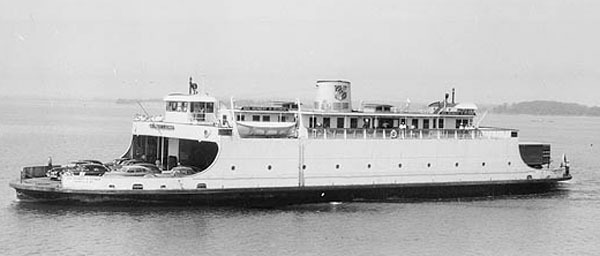As a boy growing up in Washington D.C., I used to love my summertime trips to visit my grandparents in New Jersey or the beach at Ocean City — in part because these excursions meant a ferry ride across Chesapeake Bay. The ferry crossed the four-mile stretch from Sandy Point on the western shore to Kent Island on the eastern shore — the narrowest point in the bay. Little did I know that 60 years later I would ride the same ferry every day across the 1.4 miles from Tahlequah to Point Defiance.
Ferries began running on the Chesapeake Bay very early in our country’s history, and with the advent of the automobile, car ferries became a necessity for crossing the 200-mile long bay. Plans to bridge the bay began in the early 1900s, but it was not until the late 1930s that Maryland began to plan in earnest and purchased the ferry system that ran where the bridge would be built, since the bridge would put the ferries out of business. The state-owned Chesapeake Bay Ferry System built two new 48-car ferries in 1947, the Gov. Harry W. Nice and the Gov. Herbert R. O’Conor, to handle the increased traffic of the post-World War II era.
The fate of these ferries was set in 1949 when ground was broken for the new Chesapeake Bay Bridge. The new bridge opened on July 30, 1952, and the last ferry run was made six months later on New Year’s Eve. According to the Baltimore Sun, “It was the end — and the beginning — of an era.”
The Washington State Ferries, then known as the Washington State Toll Bridge Authority, was formed in 1951 when the state purchased the monopolistic Puget Sound Navigation Company (known as the Black Ball Fleet) after a series of shutdowns and strikes disrupted ferry service on the Sound. These disruptions were so severe that Vashon raised $1,500, formed King County Ferry District 1 and operated a three-boat ferry service from 1948 to 1951. When the state ferry system was created, Vashon’s system was incorporated into the new one.
The new state ferry system desperately needed ferries until its Evergreen class ferries were completed, and it just so happened that those two relatively new Chesapeake ferries were for sale. So Washington state purchased them and had them towed to Seattle through the Panama Canal by the Puget Sound Tug & Barge Company tugs Monarch and Wando. The trip took over a month. When the ferries arrived, they were overhauled, cleaned, repainted in the green and white of the Washington ferry fleet and renamed. The Gov. Herbert R. O’Conor became the Rhododendron, and the Gov. Harry W. Nice was christened the Olympic.
The Rhododendron worked the Lofall-Southpoint route on Hood Canal for eight years until the new Hood Canal Bridge was completed in 1961. The Rhododendron was then shifted to the Mukilteo-Clinton route, where she worked alongside the Olympic. In 1974, the state took over the Port Townsend-Keystone route and the Rhody and the Olympic worked that route until the early 1980s.
The Rhody was mothballed in 1983, then, in 1990, it was sent to the shipyard for a rebuild, where workers discovered a ship so deteriorated that its entire cabin had to be replaced, new engines installed and the hull substantially rebuilt. The cost overruns caused a similar project for the Olympic to be cancelled; the ferry was ultimately sold at auction in 1997 and is currently moored on Ketron Island near Steilacoom.
When the Rhody emerged from the shipyard in 1993, she was assigned to the Point Defiance-Tahlequah route, where she served until Monday, replaced by the Chetzemoka, the state’s new Kwa-di Tabil Class ferry.
Each day when I rode the Rhody in the shadow of Mount Rainier and watched the ever-changing activity of Dalco Passage, I would think back to that time when I sailed on the same ship, crossing the Chesapeake Bay and watching the crabbers and shrimpers at work. Now, the Chetzemoka has begun its service, and perhaps it, too, will offer up dreams that I will one day ponder with nostalgia.
— Bruce Haulman is an Island historian.


